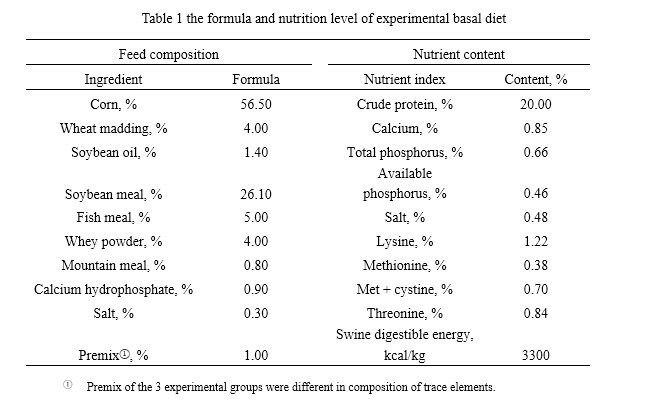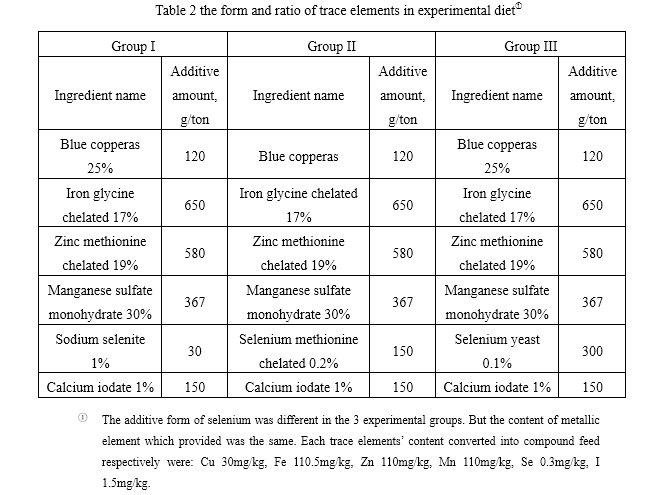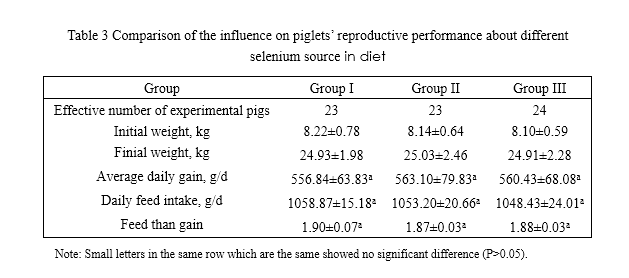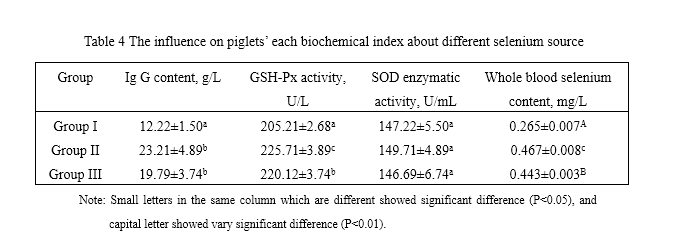Summary: Summary: A randomized block design experiment was conducted with 72 crossbred (Duroc × Landrace × Yorkshire) pigs (36 males and 36 females), 24 pigs (12 of each sex) were assigned to each treatment, and treatment groups were assigned randomly to pens in 3 replications. 3 treatment groups all used corn and soybean meal diet which were same except the additive form of selenium. Group I added selenium that of the form of sodium selenite 0.3mg/kg. Group II added selenium that of the form of selenium methionine chelate 0.3mg/kg. Group III added selenium that of the form of selenium yeast chelate 0.3mg/kg. The results showed that Group II and group III had no significant difference in improving the daily gain, feed intake and feed than gain of piglets with Group I. And the content of immune globulin (IgG) and the activity of glutathione peroxidase (GSH-Px) of Group II and group III significant higher then Group I. The content of blood selenium of Group II and group III very significantly higher than Group I. There was no significant difference of the activity of blood superoxide dismutase (SOD) among the 3 groups.
Keywords: trace elements; selenium methionine chelate; piglets; IgG
As the competition of industry increased, research institutions and enterprise of feed additive and breeding have more and more attention to chelating trace elements. Compare to the first generation of inorganic trace elements and the second generation of simple organic trace elements, the third generation of chelating trace elements has some unique advantages such as high bioavailability, good palatability, less damage to nutrient in feed and improving animals’ immunity.
Piglets, especially which after weaning two weeks, have special requirements on feed quality, including high nutrient concentration and digestive rate, good palatability of feed, and improving disease-resistant of piglets, etc. Adding chelating organic trace elements instead of inorganic trace elements in piglets’ feed has a special meaning from that perspective.
The purpose of this study is to compare the using effect of sodium selenite, selenium yeast and selenium methionine chelate through the way of investigating the reproductive performance of weaning piglets, immune globulin (IgG), activity of glutathione peroxidase (GSH-Px) and superoxide dismutase (SOD), content of blood selenium. And it provides the reference for the proper use of trace element selenium.
1.Materials and Methods
1.1 Time and place
The experiment was started in Wanda experimental basal piggery in Xiantao, Hubei on April 20th to May 26th, 2015.
1.2 Experimental animals and group
A randomized block design experiment was conducted with 72 crossbred (Duroc × Landrace × Yorkshire) pigs (36 males and 36 females), 24 pigs (12 of each sex) were assigned to each treatment, and treatment groups were assigned randomly to pens in 3 replications. Feeding 3 kinds of experiment diet respectively.
1.3 Experimental diet
The experiment was divided into 3 groups: 3 treatment groups all used corn and soybean meal diet which were same except the additive form of selenium. Group I added selenium that of the form of sodium selenite 0.3mg/kg. Group II added selenium that of the form of selenium methionine chelate 0.3mg/kg. Group III added selenium that of the form of selenium yeast chelate 0.3mg/kg. (Table 1 and Table 2).
All kinds of test feed were pressed for granular material.


1.4 Experimetal materials
Iron glycine chelate, Zinc methionine chelate, Selenium methionine chelate: Produced by Wuhan Pharma Chemical Co., Ltd.
Selenium yeast: Produced by a foreign company.
1.5 Raising management
The experimental period were total 35 days. Pilot test were 5 days. Formal test were 30 days. Experimental pigs were raised in the same nursery and web high bed of the same toward. They could be free to feed themselves and drink. Immune and raise procedures according to conventional piggery.
Preparing work finished in the day before the afternoon of piglets’ pilot test. Gave each group corresponding test feed the next morning. Fasting weighted, calculated feed and began to test in the morning of formal period.
1.6 Experimental index
1.6.1 Reproductive performance
Recorded daily feed intake and gaily gain of piglets of each group.
Feed than gain (F/G) = feed consumption /weight gain.
1.6.2 Blood biochemical indicator
Randomly chose two piglets of each column when the experiment was over, and drew blood respectively in anterior vena cava. After standing for half an hour, sucked upper transparent serum and packed respectively in small glass bottles, then stored in refrigerators (-20℃) for use.
Use enzyme linked immunosorbent assay (ELISA)to determine serum IgG concentrations.
Use xanthine oxidase method to determine serum SOD enzymatic activity.
Use dithiol nitro benzoic acid method to determine GSH-Px activity.
Use hydride generation atomic fluorescence spectrometer (HG-AFS) to determine the content of selenium in blood.
1.7 Statistical analysis
After initial handling of experimental data by Excel, used software SPSS17.0 to do the variance analysis.
2 Results and analysis
2.1 The influence on weaning piglets’ daily gain, feed intake and feed than gain about different
selenium source.
Analyzed by table 3, the differences of the daily gain, feed intake and feed than gain of piglets in the 3 groups were not significant (P>0.05).

2.2 The influence on piglets’ each biochemical index about different selenium source.

It was clear that from table 4, the content of piglets’ serum in Group II (adding selenium methionine chelate ) and Group III (adding selenium yeast) obviously higher than Group I (adding inorganic selenium) (P<0.05). GSH-Px activity of Group II and Group III obviously higher than Group I.
3 Conclusion
In the experiment, the influence on piglets’ reproductive performance about selenium methionine chelate, selenium yeast and sodium selenite were indifference. The few additive amount of selenium was difficult to show the enhanced effects of reproductive performance. Manhan (1999) also reported that piglets’ reproductive performance about organic selenium or inorganic selenium had no effect with feed than gain.
Jianzhong Huang (2004) reported that GSH-Px and SOD enzymatic activity in blood were the important index of reflecting the oxidation resistance of body. In the experiment, GSH-Px enzymatic activity in blood of Group II (adding selenium methionine chelate ) and Group III (adding selenium yeast) obviously higher than Group I (adding sodium selenite), and it explained that organic selenium could improve the oxidation resistance of pigs. Analyzed by the content of selenium in blood, the content whole blood selenium of Group II and Group III significantly higher than Group I, and it explained that organic selenium was more easier to be absorbed in the intestinal. Organic selenium translated into selenocysteine in the body may promote the synthesize of GSH-Px and improve GSH-Px activity in blood. Kim (2001) reported that the oxidation resistance of organic selenium was better than inorganic selenium, so it was necessary to use organic selenium instead of inorganic selenium for the selenium supplements of piglets. At the same time, IgG was short for immune globulin G, which was one of the highest contents of serum immune globulin and the main component of serum antibodies that could represent piglets’ disease-resistant ability. IgG content of Group II (adding selenium methionine chelate ) and Group III (adding selenium yeast) obviously higher than Group I (adding sodium selenite), so it explained that groups of organic selenium had improved immunocompetence of pigs’ body.
The research of Zhanyong Wei (2005) and Zirong Xu (1992) showed that inorganic selenium was absorbed passively in animals’ gut and organic selenium could transport like amino acid. Therefore, we consider that the absorption utilization of selenium methionine chelate and selenium yeast is higher than sodium selenite, and the content of blood selenium is improved. Piglets have higher biological utilization rate to organic selenium, and the content selenium in waste will be reduce, so the environmental pollution will be reduced. In the actual production, in order to improve animals’ immune, anti-stress and reduce environmental pollution, organic selenium replace inorganic selenium will become a trend.

